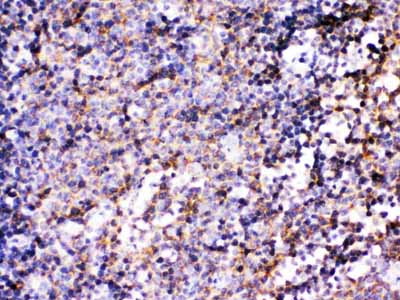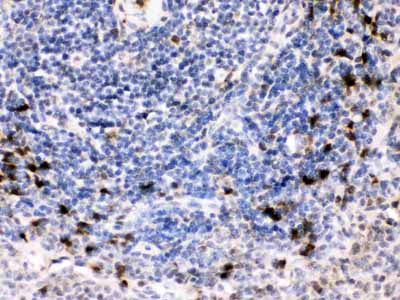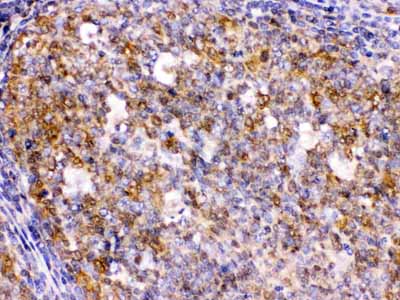Anti-BCAR3 Picoband Antibody
- SPECIFICATION
- CITATIONS
- PROTOCOLS
- BACKGROUND

Application
| WB, IHC-P |
|---|---|
| Primary Accession | O75815 |
| Host | Rabbit |
| Reactivity | Human, Mouse, Rat |
| Clonality | Polyclonal |
| Format | Lyophilized |
| Description | Rabbit IgG polyclonal antibody for Breast cancer anti-estrogen resistance protein 3(BCAR3) detection. Tested with WB, IHC-P in Human;Mouse;Rat. |
| Reconstitution | Add 0.2ml of distilled water will yield a concentration of 500ug/ml. |
| Gene ID | 8412 |
|---|---|
| Other Names | Breast cancer anti-estrogen resistance protein 3, Novel SH2-containing protein 2, SH2 domain-containing protein 3B, BCAR3, NSP2, SH2D3B |
| Calculated MW | 92566 MW KDa |
| Application Details | Immunohistochemistry(Paraffin-embedded Section), 0.5-1 µg/ml, Human, Mouse, Rat, By Heat Western blot, 0.1-0.5 µg/ml, Human |
| Tissue Specificity | Ubiquitously expressed. Found in several cancer cell lines, but not in nonmalignant breast tissue. . |
| Protein Name | Breast cancer anti-estrogen resistance protein 3 |
| Contents | Each vial contains 5mg BSA, 0.9mg NaCl, 0.2mg Na2HPO4, 0.05mg NaN3. |
| Immunogen | A synthetic peptide corresponding to a sequence at the C-terminus of human BCAR3 (791-825aa KGAQVNQTERYEKFNQILTALSRKLEPPPVKQAEL), different from the related mouse sequence by five amino acids. |
| Purification | Immunogen affinity purified. |
| Cross Reactivity | No cross reactivity with other proteins. |
| Storage | At -20˚C for one year. After r˚Constitution, at 4˚C for one month. It˚Can also be aliquotted and stored frozen at -20˚C for a longer time.Avoid repeated freezing and thawing. |
| Name | BCAR3 |
|---|---|
| Synonyms | NSP2, SH2D3B |
| Function | Acts as an adapter protein downstream of several growth factor receptors to promote cell proliferation, migration, and redistribution of actin fibers (PubMed:24216110). Specifically involved in INS/insulin signaling pathway by mediating MAPK1/ERK2-MAPK3/ERK1 activation and DNA synthesis (PubMed:24216110). Promotes insulin- mediated membrane ruffling (By similarity). In response to vasoconstrictor peptide EDN1, involved in the activation of RAP1 downstream of PTK2B via interaction with phosphorylated BCAR1 (PubMed:19086031). Inhibits cell migration and invasion via regulation of TGFB-mediated matrix digestion, actin filament rearrangement, and inhibition of invadopodia activity (By similarity). May inhibit TGFB- SMAD signaling, via facilitating BCAR1 and SMAD2 and/or SMAD3 interaction (By similarity). Regulates EGF-induced DNA synthesis (PubMed:18722344). Required for the maintenance of ocular lens morphology and structural integrity, potentially via regulation of focal adhesion complex signaling (By similarity). Acts upstream of PTPRA to regulate the localization of BCAR1 and PTPRA to focal adhesions, via regulation of SRC-mediated phosphorylation of PTPRA (By similarity). Positively regulates integrin-induced tyrosine phosphorylation of BCAR1 (By similarity). Acts as a guanine nucleotide exchange factor (GEF) for small GTPases RALA, RAP1A and RRAS (By similarity). However, in a contrasting study, lacks GEF activity towards RAP1 (PubMed:22081014). |
| Cellular Location | Cytoplasm {ECO:0000250|UniProtKB:Q9QZK2}. Cell junction, focal adhesion {ECO:0000250|UniProtKB:Q9QZK2} Note=Localization to focal adhesions depends on interaction with PTPRA {ECO:0000250|UniProtKB:Q9QZK2} |
| Tissue Location | Ubiquitously expressed. Found in several cancer cell lines, but not in nonmalignant breast tissue |

Thousands of laboratories across the world have published research that depended on the performance of antibodies from Abcepta to advance their research. Check out links to articles that cite our products in major peer-reviewed journals, organized by research category.
info@abcepta.com, and receive a free "I Love Antibodies" mug.
Provided below are standard protocols that you may find useful for product applications.
Background
Breast cancer anti-estrogen resistance protein 3 is a protein that in humans is encoded by the BCAR3 gene. Breast tumors are initially dependent on estrogens for growth and progression and can be inhibited by anti-estrogens such as tamoxifen. However, breast cancers progress to become anti-estrogen resistant. Breast cancer anti-estrogen resistance gene 3 was identified in the search for genes involved in the development of estrogen resistance. The gene encodes a component of intracellular signal transduction that causes estrogen-independent proliferation in human breast cancer cells. The protein contains a putative src homology 2 (SH2) domain, a hall mark of cellular tyrosine kinase signaling molecules, and is partly homologous to the cell division cycle protein CDC48. Multiple transcript variants encoding different isoforms have been found for this gene.
If you have used an Abcepta product and would like to share how it has performed, please click on the "Submit Review" button and provide the requested information. Our staff will examine and post your review and contact you if needed.
If you have any additional inquiries please email technical services at tech@abcepta.com.













 Foundational characteristics of cancer include proliferation, angiogenesis, migration, evasion of apoptosis, and cellular immortality. Find key markers for these cellular processes and antibodies to detect them.
Foundational characteristics of cancer include proliferation, angiogenesis, migration, evasion of apoptosis, and cellular immortality. Find key markers for these cellular processes and antibodies to detect them. The SUMOplot™ Analysis Program predicts and scores sumoylation sites in your protein. SUMOylation is a post-translational modification involved in various cellular processes, such as nuclear-cytosolic transport, transcriptional regulation, apoptosis, protein stability, response to stress, and progression through the cell cycle.
The SUMOplot™ Analysis Program predicts and scores sumoylation sites in your protein. SUMOylation is a post-translational modification involved in various cellular processes, such as nuclear-cytosolic transport, transcriptional regulation, apoptosis, protein stability, response to stress, and progression through the cell cycle. The Autophagy Receptor Motif Plotter predicts and scores autophagy receptor binding sites in your protein. Identifying proteins connected to this pathway is critical to understanding the role of autophagy in physiological as well as pathological processes such as development, differentiation, neurodegenerative diseases, stress, infection, and cancer.
The Autophagy Receptor Motif Plotter predicts and scores autophagy receptor binding sites in your protein. Identifying proteins connected to this pathway is critical to understanding the role of autophagy in physiological as well as pathological processes such as development, differentiation, neurodegenerative diseases, stress, infection, and cancer.





